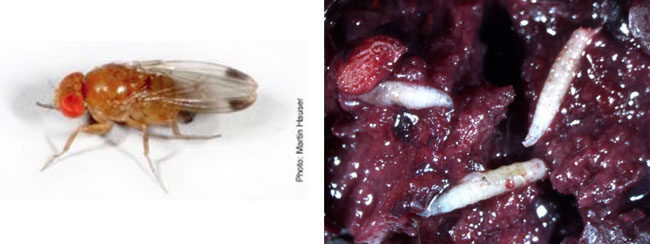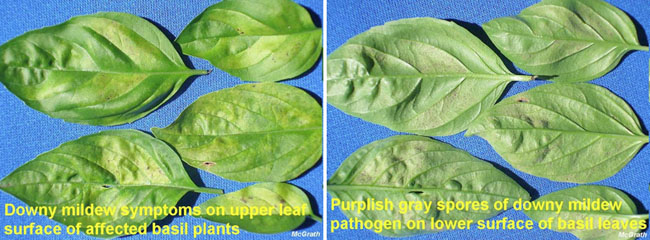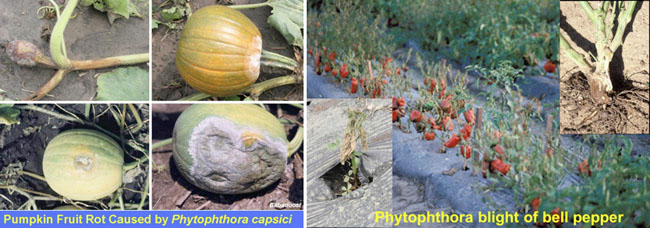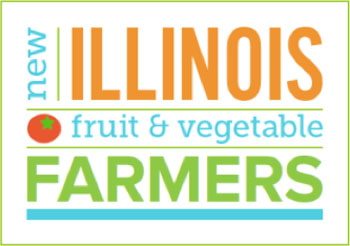"We are what we repeatedly do. Excellence, then, is not an act, but a habit." --Aristotle
Address any questions or comments regarding this newsletter to the individual authors listed after each article or to its editor, Rick Weinzierl, 217-333-6651, weinzier@illinois.edu. To receive e-mail notification of new postings of this newsletter, call or write the same number or address.
In This Issue:
Regional Updates (from Kyle Cecil in western IL)
Fruit Production and Pest Management (spotted wing Drosophila updates)
Vegetable Production and Pest Management (plant disease potential post-Isaac; UI cover crops research; late-season corn earworm control)
Local Foods Issues (SARE Youth Educator and Farmer-Rancher grant programs; "Preparing a New Generation of Illinois Fruit and Vegetable Farmers")
Upcoming Programs
Two upcoming winter programs of broad interest to Illinois commercial fruit and vegetable growers in December and January are the Great Lakes EXPO, December 4-6, and the Illinois Specialty Crops, Agritourism, and Organics Conference, January 9-11, 2013. Note the dates and contact information for these programs below.
- Organic and Conventional Management Advances for High Tunnel Systems, September 21, 2012. Learn more about organic pest management, specifically steam sterilization of soil, and other management advances in high tunnel systems at the Dixon Springs Agricultural Center, 1:00-4:00 p.m. For more information and to express your intent to attend, contact Rick Weinzierl at 217-244-2126 or weinzier@illinois.edu or Jeff Kindhart at 618-695-2770 or jkindhar@illinois.edu. Or just show up!
- Meet the Buyer, September 26, 2012. 9:00 a.m. to 5:00 p.m. at the U of I Extension office, 700 S. Airport Drive, Springfield. Buyers will be in attendance to provide an overview of their organization and their procurement needs. Farmers will have the opportunity to meet with buyers one-on-one. The program includes sessions on MarketMaker, MarketReady, and opportunities to meet produce buyers. For more information, contact Deborah Cavanaugh-Grant, 217-782-4617 or cvnghgrn@illinois.edu.
- Living on the Land, October 1 through November 9, 2012. An 8-week series held on Mondays from 6:00 p.m. to 9:00 p.m. at the University of Illinois Extension Office, Will County, 100 Manhattan Road, Joliet, IL 60433. $150 per person for the series and $100 for an additional farm/family members. For more information, contact James Theuri at 815-933-8337 or jtheu50@illinois.edu.
- Great Lakes EXPO, December 4-6, 2012. Grand Rapids, MI. A comprehensive program that covers production and marketing of a broad range of fruit and vegetable crops and farm marketing, including tracks for organic and greenhouse growers as well as "conventional" outdoor production. For more information, see http://www.glexpo.com/.
- Illinois Specialty Crops, Agritourism, and Organics Conference, January 9-11, 2013. Crowne Plaza Hotel and Conference Center, Springfield, IL. More details to come, but mark your calendars. Workshops on January 9 will cover high-tunnel production systems, cover crops, basics of orchard establishment and management, and sweet corn production and pest management. Concurrent tracks on January 10-11 include fruits, vegetables, herbs, agritourism, organic production systems, and emerging issues and challenges in specialty crop production and marketing. More detailed program information will be posted soon; for more information, see www.specialtygrowers.org; complete program will be available soon.
Regional Updates
In western Illinois, growers are benefitting from the recent rains we received compliments of Hurricane Isaac. Amounts varied a great deal but the extended area received much needed moisture. Garlic is now on the minds of many growers as they prepare for putting this popular crop in the ground. Tomato harvest and production is still strong with both the determinate and indeterminate varieties continuing to set fruit. When the first killing frost will arrive is an area of interest among growers. Other harvests, such as grapes, are coming to a close. I think most growers were surprised at just how productive the vines were this year given very trying circumstances. An experienced grower I work with reiterated an important point last week when he said "proper management, including pruning, of crops is always important...it was even more so this year." He is exactly right. The "devil is in the detail" so to speak. Lastly, fall crops are growing well in area high tunnels and growers are expecting a productive season for these crops.
Kyle Cecil (309-342-5108; cecil@illinois.edu)
Fruit Production and Pest Management
Updates -- Not Good Ones -- on Spotted Wing Drosophila (SWD)
Over the summer and especially the last few weeks, detections of spotted wing Drosophila, Drosophila suzukii, and reports of larval damage to fruit (now particularly fall raspberries) have been increasing in Illinois and nearby states including Iowa, Wisconsin, and Minnesota. Infestations have posed problems in Michigan since 2010. In Illinois, the list of counties where this is insect has been collected include Pope, Union, and Marion in the southern part of the state, Champaign, Tazewell, and Adams in the central part of the state, and Ogle County in the north. I suspect that it is present in most if not all of the counties in Illinois.

Spotted wing Drosophila adult and larvae.
Michigan State University's web site on SWD provides extensive information about this pest at http://www.ipm.msu.edu/swd.htm. Links provided on the main page of this site provide access to fact sheets, monitoring guidelines, and control recommendations.
Spotted wing Drosophila is a destructive pest of thin-skinned fruits because unlike other Drosophila species, it lays eggs into ripening fruit before it's ready for harvest. Infested fruits "melt down" from larval feeding in just a few days. Adult flies live for up to 2 weeks, and females can lay up to 300 eggs. Development from egg to adult can occur in in little as 8 days, and 10 or more generations may develop within a season.
Where SWD is present (see the MSU recommendations for building and using traps at http://www.ipm.msu.edu/SWD/SWD-monitor.htm), at this stage of the season, management is limited primarily to sanitation and insecticide application. Removing over-ripe fruit and wild hosts (plants with thin-skinned berries such as pokeweed) in and around small fruit plantings reduces the potential for population buildup. Insecticides that are effective for SWD control in brambles include:
Insecticides for SWD control in brambles |
Preharvest interval |
Days of residual activity |
|---|---|---|
Malathion |
1 |
5-7 |
Mustang Max (zeta-cypermethrin) |
1 |
7 |
Danitol (fenpropathrin) |
3 |
7 |
Brigade (bifenthrin) |
3 |
7 |
Delegate (spinetoram) |
1 |
7 |
Entrust (spinosad) -- OMRI-approved |
3 |
3-5 |
Pyganic (pyrethrins) -- OMRI-approved |
0 |
1-2 |
(Adapted from http://www.ipm.msu.edu/SWD/ManagementRecommendations-RaspberryBlackberrySep2012.pdf) |
||
Rick Weinzierl (217-244-2126; weinzier@illinois.edu)
Vegetable Production and Pest Management
Isaac's Aftermath: Possible Outbreaks of Vegetable Diseases
Following heavy rain associated with Hurricane Isaac, we may face outbreaks of downy mildew of basils, downy mildew of cucurbits, Phytophthora blight of cucurbits, and Phytophthora blight of peppers. All of these diseases are caused by oomycete pathogens. We will closely monitor development of these diseases and release recommendations as needed.
Downy mildew of basil, caused by the oomycete Peronospora belbahrii, is a new disease in Illinois (first detection was in 2009). This disease now occurs in Illinois every year. Downy mildew develops very rapidly and can cause 100% crop loss in a short period of time. Growers may realize their basil has a disease because the most noticeable symptom on affected plants is yellowing resembling a nutritional deficiency. The downy-appearing sporulation of the pathogen only develops on lower leaf surfaces. The pathogen can be observed using a hand lens. This disease can be effectively controlled by application of the fungicide mandipropamid (Revus, 8.00 fl oz/A) alternated with azoxystrobin (Quadris, 15.4 fl oz/A) or cyazofamid (Ranman, at 2.75 fl oz/A) on a weekly schedule. Quadris 2.08SC has been registered for use on herbs, and we have section 18 permits for the use of Revus 2.08SC and Ranman 400SC.

Another downy mildew, caused by Pseudoperonospora cubensis, affects all cucurbit crops. The pathogen overwinters in the southern United States where cucurbits are grown during the winter. It progresses northward with cucurbit production each spring. The pathogen might have moved from the south to Illinois with the rains associated with Isaac. The first symptom of cucurbit downy mildew is usually the appearance of indistinct, pale green areas on the upper leaf surface. The pale green areas soon become yellow in color and angular to irregular in shape, bounded by the leaf veins. The corresponding lower leaf surface is covered with a downy, pale gray to purple mildew. Mandipropamid (Revus), propamocarb (Previcur Flex), dimethomorph (Forum), famoxadone + cymoxanil (Tanos), cyazofamid (Ranman), fluopicolide (Presidio), and zaxomide + mancozeb (Gavel) are effective against downy mildew. To increase effectiveness of these fungicides, it is recommended to mix them with chlorothalonil (Bravo Weather Stik). Follow label directions.

Phytophthora blight, caused by Phytophthora capsici, is one of the most serious diseases of cucurbits and peppers in Illinois. It occurs in Illinois every year, and after this heavy rainfall, it will likely develop in cucurbit and pepper fields with a history of Phytophthora blight. The infection usually appears first in low areas of the fields where soil remains wet longer. P. capsici causes crown rot, vine lesions, and fruit rot in cucurbits, and root rot and crown rot of peppers. In pepper fields, application of one of the following fungicides will help to minimize losses: mefenoxam (Ridomil Gold), Mandipropamid (Revus), and cyazofamid (Ranman). In cucurbit production, the following practices can help to manage Phytophthora blight: (i) scout the field for the Phytophthora blight symptoms, particularly in low areas; (ii) when symptoms are localized in a small area of the field, disk the area; (iii) discard infected fruit, but not in the field; (iv) remove healthy fruit from the infested area as soon as possible and check them routinely for infection; (v) do not display fruit for sale in an area that is infested with P. capsici; and (vi) apply fungicides at the first sign of the disease. The following fungicides are effective against P. capsici isolated in Illinois: mandipropamid (Revus), fluopicolide (Presidio), cyazofamid (Ranman), dimethomorph (Forum), famoxadone + cymoxanil (Tanos), and zaxomide + mancozeb (Gavel). Application of the fungicides should begin at the first sign of the disease and made at weekly interval. Follow label direction carefully.

Mohammad Babadoost (217-333-1523; babadoos@illinois.edu)
Planning Ahead for Next Spring's Cover Crops... How Does Spring Planting Time Affect Mustard Growth and Weed Growth?
One spring cover crop we have evaluated is mustard. It's generally thought of as an early spring crop. Mustards, when incorporated into the soil, release glucosinolates that break down into isothiocyanates. Isothiocyanates serve as general fumigants, inhibiting microorganisms and weeds. Concentration of isothiocyanates is critical for their effectiveness.
Ida Gold mustard was planted at five times during the spring, April 24, May 4, May 14, May 29, and June 4. Samples of these mustards were harvested approximately 5 weeks after planting, on June 7, June 15, June 26, July 4, and July 13, when they were at full flowering. After sampling, the mustards were mowed and incorporated by a disk.
Mustard biomass was measured at approximately the same number of degree-days. Growth was better in cooler temperatures and ranged from 17 g/ft.2 for the April 24 planting to 2 g/ft.2 for the June 4 planting. Compared to the bare ground control, weeds were reduced in the April 24 and May 14 plantings. This illustrates that biomass of mustard did not correlate with weed control because biomass of mustard planted on April 24 was 17 g/ft.2 while mustard planted on May 14 was only 10 g/ft.2.
The take-home message for farmers is that further research on spring planting times is needed before we can recommend use of mustard as a biofumigant and cover crop. The system is complex and at this stage there's a lot we do not understand.
Sometimes the most recent news is still not decisive.
John Masiunas (masiunas@illinois.edu) and Dan Anderson
A Late-season Reminder on Corn Earworm
Counts of corn earworm moths have declined in pheromone traps at many but not all locations in the last week. Even so, female corn earworm moths are now concentrating all their egg-laying in the few host crops that remain attractive and viable for larval survival and development -- late sweet corn, tomatoes, peppers, and green beans. Sweet corn and tomatoes are preferred hosts.
Although in general most growers have been successful with corn earworm control programs that have relied on pyrethroids (Mustang Max, Brigade, Warrior, and similar generic products) or Coragen, there have been reports of poor control on some farms. Where spray coverage has been good and applications made on the right intervals (as often as every 2-3 days when moth counts and temperatures are very high), poor control likely has resulted from one or both of the following causes. Resistance to pyrethroids remains a scattered but significant problem, so where spray programs have relied almost entirely on pyrethroid insecticides, failures are probably the result of resistance. Unsatisfactory control in fields where Coragen was used exclusively may result simply from the fact that although it's very effective, we have never observed 100 percent control in research evaluations. When a very small percentage of larvae (even 1 or 2 percent) survive sprays, damage can be extensive if moth populations are really high and multiple eggs are laid on each ear.
The most aggressive approach now for late season earworm control in sweet corn is to combine a pyrethroid with Coragen or Belt, with both ingredients at rates in the middle of the ranges recommended on their labels. A premix that includes the active ingredients found in Coragen and Warrior is Voliam Xpress.
Rick Weinzierl (217-244-2126; weinzier@illinois.edu) and Megan Brant
Local Foods Issues
SARE Grant Programs Open for Applications -- Youth Educator and Farmer-Rancher Grants
The 2013 North Central Region - Sustainable Agriculture Research and Education Program (NCR-SARE) Youth Educator Grant Call for Proposals is now available. Youth Educator Grant projects provide opportunities for youth in the North Central Region to learn more about sustainable agriculture (farming and ranching that is ecologically sound, profitable, and socially responsible). Educators use the grants to encourage young people and their parents to try sustainable practices and see sustainable agriculture as a viable career option. Projects should help youth discover that sustainable farming and ranching is profitable; good for families, communities, and their quality of life; and good for the environment long term.
Grants are awarded at a $2,000 maximum, and a total of approximately $20,000 is available for this program. Grant recipients have 25 months to complete projects. Interested applicants can find the call for proposals online as well as useful information for completing a proposal at http://www.northcentralsare.org/Grants/Our-Grant-Programs/Youth-Educator-Grant-Program. You can find more information about sustainable agriculture at http://www.sare.org/ or take a free National Continuing Education Program online course about the basic concepts at http://www.sare.org/Learning-Center/Courses-and-Curricula. Proposals are due by 4:30 pm, Thursday, November 15, 2012 at the NCR-SARE office in Saint Paul, MN.
The 2013 NCR-SARE Farmer Rancher Grant Call for Proposals also is now available. Farmers and ranchers in the North Central Region are invited to submit grant proposals to explore sustainable agriculture solutions to problems on the farm or ranch. Proposals should show how farmers and ranchers plan to use their own innovative ideas to explore sustainable agriculture options and how they will share project results.
Grants are used to conduct projects that solve challenges farmers face and to develop information on what works and what doesn't so that other farmers and ranchers facing those same challenges can benefit from the results of the funded project. The grants are not designed to pay a farmer to farm. They are designed to take some of the financial risk away from trying a new solution.
Projects should emphasize research or education/demonstration. There are three types of competitive grants:
- Individual grants ($7,500 maximum)
- Partner grants for two farmers/ranchers from separate operations who are working together ($15,000 maximum)
- Group grants for three or more farmers/ranchers from separate operations who are working together ($22,500 maximum)
NCR-SARE expects to fund about 45 projects in the twelve-state North Central Region with this call. A total of approximately $400,000 is available for this program. Grant recipients have 25 months to complete their projects. Interested applicants can find the call for proposals and more useful information for completing a proposal online at the NCR-SARE website (http://www.northcentralsare.org/) under the "Grants" heading. Proposals for this category (Farmer-Rancher Grants) are due on Thursday, November 29th at 4:30 p.m. at the NCR-SARE office in Saint Paul, MN.
Potential applicants with questions can contact the Illinois State Sustainable Agriculture Coordinator -- Rick Weinzierl (weinzier@illinois.edu), or Mary Hosier (mhosier@illinois.edu), Illinois SARE Project Manager with any questions.
USDA-funded Grant for Preparing a New Generation of Illinois Fruit and Vegetable Farmers

"Preparing a New Generation of Illinois Fruit and Vegetable Farmers" is a new year-long training program to be offered each of the next three years. It targets aspiring farmers, farmers with less than five years' experience, and commodity farmers interested in diversifying their operations. The program will provide programs of classroom and hands-on, in-field instruction on essential skills and information so that new growers have the knowledge to be successful fruit and vegetable farmers. High school and community college agriculture instructors are also invited to apply. Programs will be offered at the University of Illinois Research Centers in southern Illinois at Dixon Springs, central Illinois at Urbana, and northern Illinois at St. Charles. This program is funded by the USDA NIFA's Beginning Farmer and Rancher Development Program to increase the number of commercial fruit and vegetable farmers in Illinois.
A full program will be offered at all three locations and topics will include: land acquisition and transfer, business planning, legal issues, insurance, marketing, farm safety, food safety, Farm to School, equipment operation and safety, transplant production, high tunnel construction and operation, irrigation, soils and soil testing, cover crops and tillage, variety evaluations, pest and disease scouting, integrated pest management, pesticide application, pruning and thinning, harvest practices, post-harvest handling, conventional and organic production, produce farm visits, discussions with experienced farmers, and access to incubator plots ... and more.
Monthly sessions will be on Saturdays, 9:00 a.m. to 4:00 p.m., from December, 2012 through November, 2013. For more information and to request an application, see http://newillinoisfarmers.org/ or contact Rick Weinzierl, Department of Crop Sciences at 217-244-2126 or weinzier@illinois.edu or Mary Hosier at 217-333-7512 or mjhosier@illinois.edu.
Less Seriously ...
A professor was giving a big test one day. He handed out all of the tests and went back to his desk to wait.
Once the test was over the students all handed the tests back in. The professor noticed that one of the students had attached a $100 bill to his test with a note saying "A dollar per point."
The next class the professor handed the graded tests back out. This student got back his test, his test grade, and $64 change.
University of Illinois Extension Specialists in Fruit and Vegetable Production & Pest Management
Extension Educators – Local Food Systems and Small Farms |
||
Bronwyn Aly, Gallatin, Hamilton, Hardin, Pope, Saline, and White counties |
618-382-2662 |
|
Katie Bell, Franklin, Jackson, Perry, Randolph, & Williamson counties |
618-687-1727 |
|
Sarah Farley, Lake & McHenry counties |
847-223-8627 |
|
Nick Frillman, Woodford, Livingston, & McLean counties |
309-663-8306 |
|
Laurie George, Bond, Clinton, Jefferson, Marion, & Washington counties |
618-548-1446 |
|
Zachary Grant, Cook County | 708-679-6889 | |
Doug Gucker, DeWitt, Macon, and Piatt counties |
217-877-6042 |
|
Erin Harper, Champaign, Ford, Iroquois, and Vermillion counties |
217-333-7672 |
|
Grace Margherio, Jackie Joyner-Kersee Center, St. Clair County |
217-244-3547 |
|
Grant McCarty, Jo Daviess, Stephenson, and Winnebago counties |
815-235-4125 |
|
Katie Parker, Adams, Brown, Hancock, Pike and Schuyler counties |
217-223-8380 |
|
Kathryn Pereira, Cook County |
773-233-2900 |
|
James Theuri, Grundy, Kankakee, and Will counties |
815-933-8337 |
|
Extension Educators – Horticulture |
||
Chris Enroth, Henderson, Knox, McDonough, and Warren counties |
309-837-3939 |
|
Richard Hentschel, DuPage, Kane, and Kendall counties |
630-584-6166 |
|
Andrew Holsinger, Christian, Jersey, Macoupin, & Montgomery counties |
217-532-3941 |
|
Extension Educators - Commercial Agriculture |
||
Elizabeth Wahle, Fruit & Vegetable Production |
618-344-4230 |
|
Nathan Johanning, Madison, Monroe & St. Clair counties |
618-939-3434 |
|
Campus-based Extension Specialists |
||
Kacie Athey, Entomology |
217-244-9916 |
|
Mohammad Babadoost, Plant Pathology |
217-333-1523 |
|